Coventry Corporation Tramways
History
Coventry Corporation became a tramway owner on the 1st January 1912 when it took over the tramway system and associated assets of the Coventry Electric Tramways Company, which was a subsidiary of the New General Traction Company. The 3ft 6ins-gauge tramway had been operating since 1895, a relatively early date for an overhead electric tramway, and had proven to be a profitable concern. This, and the general mood of the period, which was inclined towards municipal ownership, inevitably turned the corporation's collective thoughts towards its acquisition. With this in mind, the corporation succeeded in having a 'right to buy' clause inserted into the Coventry Electric Tramways Act of 1903, which the company had submitted in order to build a number of extensions; this gave the corporation the right to purchase the tramway as a going concern after seven years, and at seven-year intervals thereafter.
The first of these acquisition dates fell due in 1910, ahead of which the corporation commissioned a survey of the tramway from the General Manager of Birmingham Corporation Tramways, Alfred Baker. Although Mr Baker noted that the tramcar fleet was old, and that various other aspects of the tramway's infrastructure were in need of investment, he still felt that the price the corporation would have to pay would inevitably give rise to a charge on the rates. Despite the warning, which was to prove prophetic, the corporation pressed on with the purchase, which ended up in arbitration, the two sides presumably being unable to agree a price. The corporation eventually had to pay £220,638, repayable over 30 years, for the privilege of owning the tramway.
The corporation immediately set about putting the system in order, continuing the construction of a new tramcar that had been started by the company, and ordering ten new tramcars to replace some of the older vehicles amongst the 42 it had inherited. The corporation had also given some thought to providing transport services to areas the trams did not serve, and in 1913, it successfully obtained powers to run motorbuses. The first motorbus service commenced on the 30th March 1914, though the corporation's foray into this area was destined to be short-lived, the government requisitioning all 6 of its vehicles in the following September.
Like most other tramways systems in the United Kingdom, Coventry's suffered during the Great War from loss of men (and their skills) to the armed services, and restrictions on acquiring new vehicles and track. As a result, the tramway emerged from the conflict in run-down condition. Perhaps surprisingly, especially in view of the onerous debt repayments, and the greatly increased post-war cost of materials, the corporation chose to invest heavily in the tramway, renewing the track on all but two of its lines, and converting as many sections as possible to double track. This work was started in 1919 and completed in 1925, a period during which another ten new trams were procured.
Powers to extend to the tramway were acquired in 1920, though only one of the lines was built, a link between the Railway Station and Earlsdon lines, which eventually opened in May 1926. The corporation also returned to motorbus operation, recommencing services in November 1919 using 7 vehicles, and steadily expanding the service and the numbers throughout the 1920s. The bus services were, however, carefully planned so that they met the needs of the populace, but without competing with the tramway routes.
The tramway system was extended one last time with powers obtained in 1929, but only a short distance at the extremity of the Stoke line, in order to serve the GEC factory there (opened September 1930); this took the tramway system to its greatest extent under the corporation, 13.6 miles. From the city centre (Broadgate), lines radiated: southwards to Coventry Station; westwards along Spon Street to Allesley Road, where the terminus was situated opposite Mount St, with a branch leading off southwestwards to a terminus opposite St Barbara's Church in Earlsdon, and with a connecting line to the Station line along Queens Road; and northwards via Bishops Street, Foleshill and Longford to a terminus in Bedworth High Street. A network of lines also branched off from Bishop Street eastwards along Hales Street, whereupon they divided into three: one line heading northeastwards via Stoney Stanton Road to a terminus opposite Henry Road in Bell Green; and the others heading to the terminus opposite Uxbridge Avenue in Stoke, one via Ford Street and Lower Gosford Street (the southern loop), and the other via White Street and Paynes Lane (the northern loop), after which they rejoined one another at Gosford Green.
The success of the motorbus operation eventually led to thoughts of tramway abandonment, the first line to go being to Allesley Road on the 5th March 1931. The appointment of a new, modernising manager in 1933 quickened the pace, the number of buses rising from 69 on 1935 to 140 in 1939. Tramway abandonment proceeded steadily, the Ford Street to Gosford Green line going on the 8th March 1936; the Earlsdon line on the 11th April 1937; the Station line on the 18th July 1937; and Stoke line on the 12th August 1939. The latter was, however, to have a short reprieve, the line being re-opened on the 18th August 1940 as a result of the impact of petrol rationing on bus operation.
Although Coventry suffered from air raids during late 1940, they reached a whole new level on the night of the 14th November when 515 enemy bombers destroyed large swathes of the city, killing over 550 people in the process. Although hardly any tramcars were destroyed, the damage to the lines and in particular, the electricity generation and distribution infrastructure, meant that the system was unable to function. The corporation took the decision to suspend tramway operation for the duration of the war on the 24th December 1941, formally abandoning the system 6 weeks later on the 3rd February 1941.
The tramway was well run, and though losses were made in some years, these were entirely due to the significant yearly debt repayments, the tramway only being a year away from paying these off completely when it was abandoned.
Uniforms
Following its acquisition of Coventry Electric Tramways, the corporation appears to have lost little time in replacing the uniforms of the erstwhile company. Motormen were issued with double-breasted, lancer-style tunics with five pairs of buttons (narrowing from top to bottom and bearing the full system title and the arms of Coventry — see link) and stand-up collars. The latter bore an employee number on the bearer's left-hand side, in individual metal numerals, whilst the right-hand side bore 'C C T', in individual metal initials. Motormen's tunics also carried a stripe on the right-hand cuff; this was in a lighter coloured material than the main body of the tunic.
Conductors on the other hand were issued with single-breasted jackets with five buttons, two breast pockets (with button closures), epaulettes (again with button closures) and stand-up collars; the latter carried the same insignia as motormen's tunics, whereas the epaulettes — which were not present on motormen's tunics — carried a badge comprising the arms of the city and the full system title: 'COVENTRY CORPORATION TRAMWAYS'. These have survived in both brass and nickel, suggesting that a transition was made from one material to the other at some point, probably from brass to nickel.
Tramcar crew caps were of the tensioned-crown type with a glossy peak and a chin strap; they bore off-the-shelf, script-lettering grade badges, along with a small municipal device badge (worn above). Surviving photographs suggest that the grade badges were 'Conductor' and 'Driver', though by the 1920s, the latter appear to have given way to the 'Motorman' equivalent.
At some point in the 1920s or early 1930s, the uniforms were changed to a more modern double-breasted design with four pairs of buttons and lapels; the collars bore the same insignia (employee number and 'C C T' initials) that was applied to the earlier stand-up collars.
Although the style of the cap remained unchanged throughout the lifetime of the municipal tramway, by the early to mid 1930s, the grade badges had fallen out of use, leaving the small municipal-device badge as the sole cap adornment.
Several photographs have survived that show the right-hand sleeve of the uniform jackets bearing a number of stars; these almost certainly signified length of service or good conduct.
Tramcar crews were also issued with double breasted greatcoats with high fold-over collars; these garment do not appear to have borne any insignia. In later years (i.e., from the 1930s), conductors were also issued with lightweight dustcoats (presumably in summer only). These were double-breasted with four pairs of buttons, three pockets (with button closures), lapels and high fold-over collars; the latter were of a darker-coloured material than the rest of the coat. They do not appear to have carried any badges.
Given that the name of the department was changed in the late 1930s — to 'Coventry Corporation Transport' — it is possible that uniforms issued in the last few years of tramway operation bore 'Coventry Corporation Transport' buttons.
Inspectors initially wore elaborate single-breasted 'bandmaster' jackets edged in a fine silk-like material, and embellished with ostentatious trappings, including faux loops and corded epaulettes. Their tensioned-crown peaked caps bore the grade —'Inspector' — in embroidered script lettering (on a hat band). This style of jacket was almost certainly superseded by a more modern design after the Great War, though photographs evidence for this has so far proven elusive.
In common with many tramway operators, Coventry Corporation recruited women during the Great War to replace male staff lost to the armed forces. Although they were certainly employed as conductresses, it is currently unclear whether they ever took on driving or inspector duties. Conductresses initially wore informal attire, though they were eventually provided with tailored jackets, and long matching skirts. The jackets bore seven buttons, a waist belt, two breast pockets (with button closures) and high fold-over collars; the latter do not appear to have carried insignia of any kind. The peaked caps had a wide, tensioned crown; they bore script-lettering grade badges, sometimes with, and sometimes without, a small municipal-device badge.
Women were also employed during the Second World War. It is unclear what uniforms were provided, as surviving photographs show them wearing the standard style of light-coloured dustcoat issued to male conductors. Headgear took the form of a felt bonnet with a wide brim, which bore the small municipal-device badge.
Further reading
For a short historical account of the tramways of Coventry, see 'Coventry Transport 1884-1940' by A S Denton and F P Groves (Birmingham Transport Historical Group; 1985).
Images
Motormen and conductors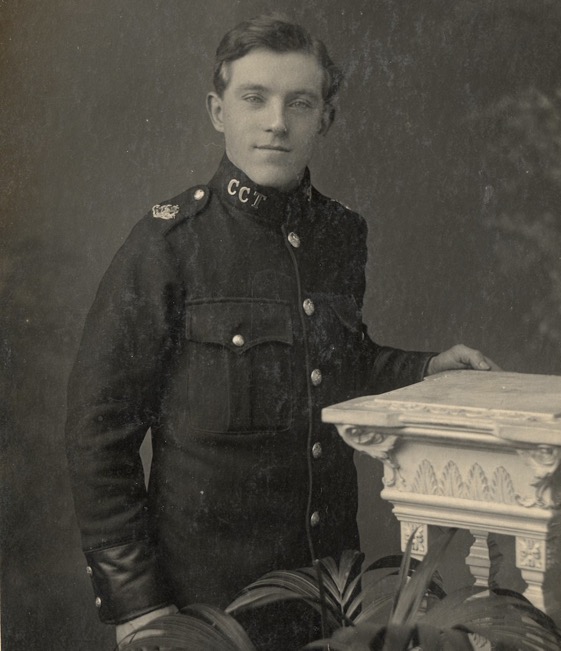
A studio portrait of a Coventry Corporation Tramways conductor — photo undated, but probably taken between 1912 and the Great War. Author's Collection.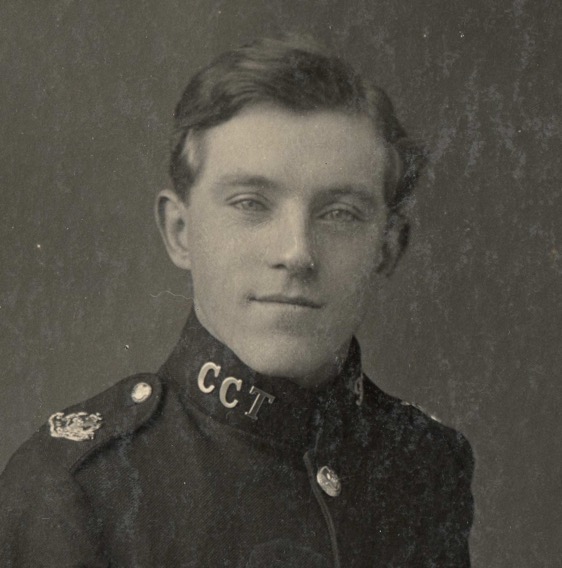
An enlargement of the above photograph showing the collar and epaulette insignia. Unfortunately, the subject is not wearing his cap.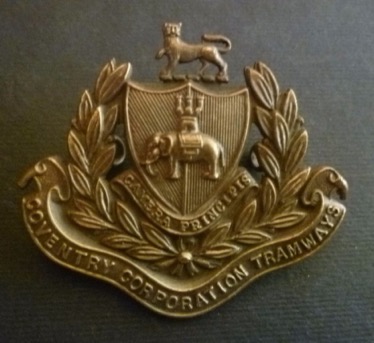
A CCT conductor's epaulette badge — brass. Most surviving badges are nickel, which tends to suggest that they superseded the brass issues at some point. Author's Collection.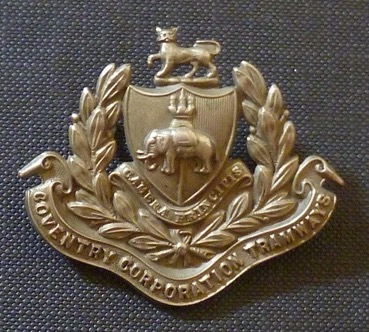
A CCT conductor's epaulette badge — nickel. In later years, these were sometimes worn as cap badges. Author's Collection.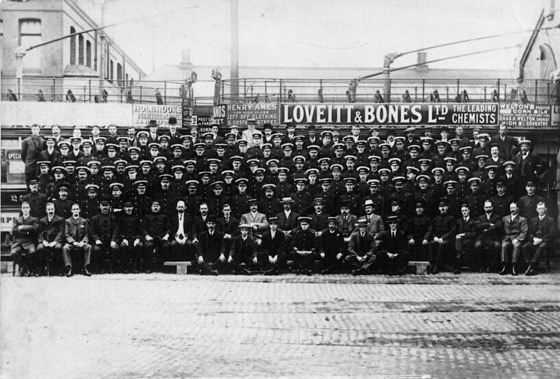
A staff photo taken in Priestleys Bridge depot yard — photo undated, but probably taken around the time the corporation took over, i.e., 1912. Photo courtesy of the Tramways and Light Railway Society, with thanks to David Voice.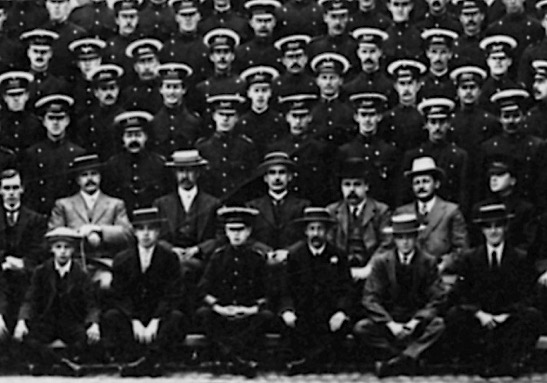
An enlargement of the above photograph, which though of poor quality, does show that the caps bore a small badge above the script-lettering grade badge.
Standard off the shelf’ script-lettering grade badges of the type used on CCT tramcar crew caps — brass. Although conductor epaulette badges have survived in both brass and nickel, jacket buttons have only survived in nickel. Author's Collection.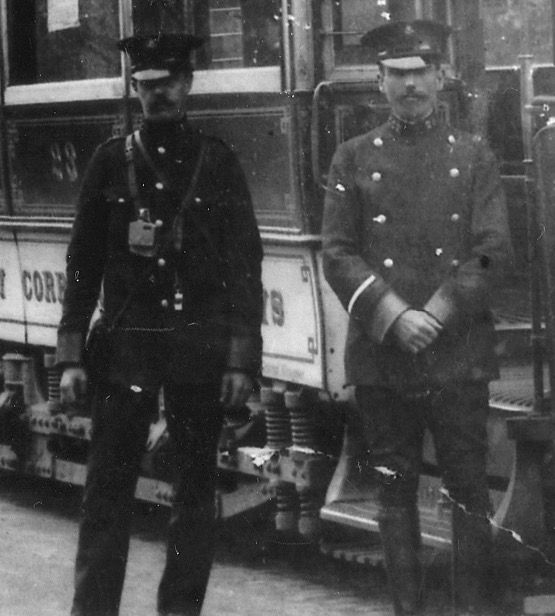
A conductor and a motorman pose with Tramcar No 23 — photo undated, but certainly taken between 1912 and the Great War. The motorman's collar initials can be clearly seen, as can the stripe on his right sleeve. Photo reproduced with the kind permission of Mr T Wilson of Travel Lens Photographic.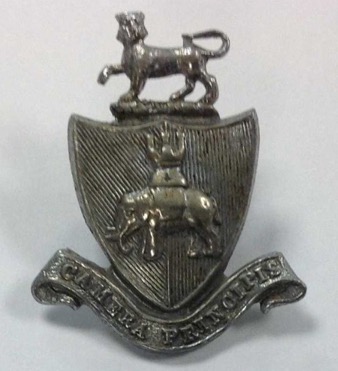
Coventry municipal-device badge, almost certainly of the pattern used on CCT tramcar crew caps — nickel. Author's Collection.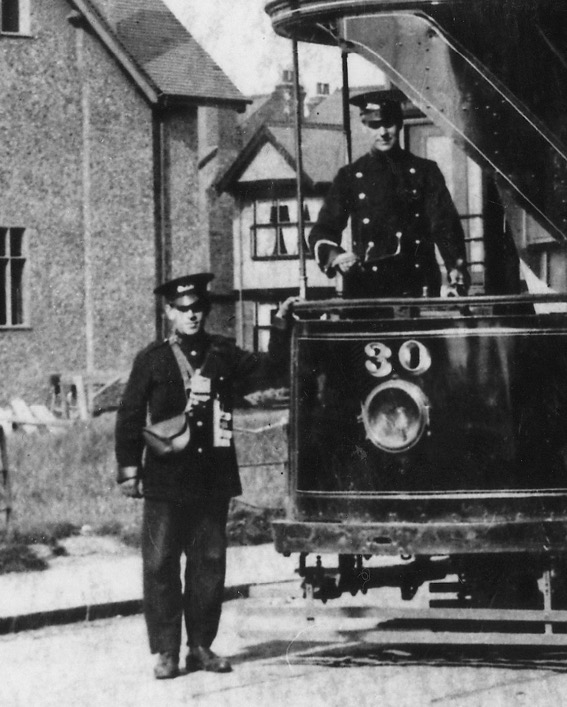
A conductor and a motorman pose with Tramcar No 30 on Route No 8 — photo undated, but probably taken in the 1920s; Tramcar No 30 was converted to a snowplough in 1933. Both men appear to wearing script-lettering cap badges only, though the shading effect of the crown (cap top) makes this difficult to say for certain. Photo reproduced with the kind permission of Mr T Wilson of Travel Lens Photographic.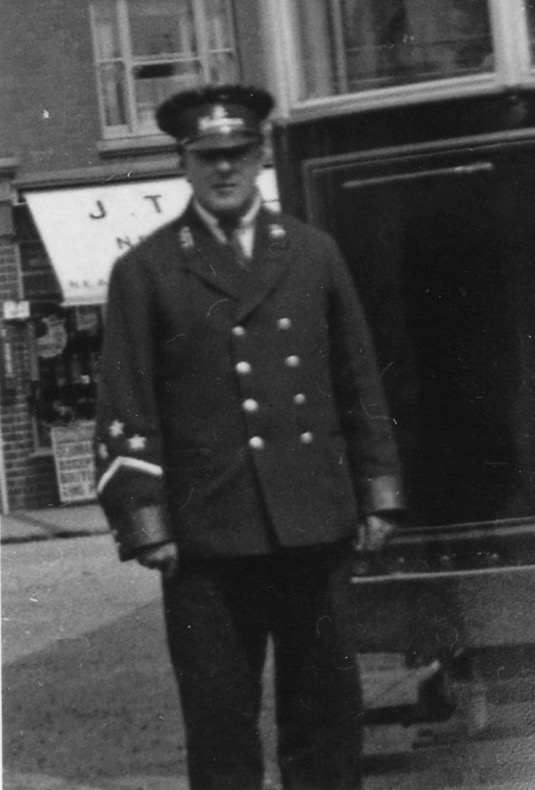
A motorman poses with Tramcar No 44 on a service to Bell Green on Route No 5 — photo undated, but probably taken in the late 1920s or early 1930s. Although the precise meaning of the three stars on his right-hand sleeve is unclear, they almost certainly denoted length of service or good conduct. The script-lettering cap badge is definitely of the 'Motorman' variety. The photograph was probably taken by the late Alf Owen, and is reproduced with the kind permission of Mr T Wilson of Travel Lens Photographic.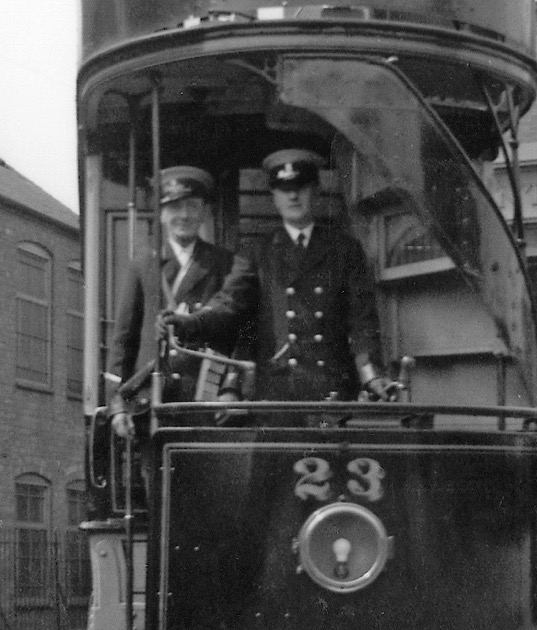
A conductor and a motorman pose with Tramcar No 23 outside Foleshill Depot — photograph undated, but probably taken in the early 1930s. Both men are wearing script-lettering grade badges and a small municipal-device badge. The photograph was more than likely the work of the late Alf Owen, and is reproduced with the kind permission of Mr T Wilson of Travel Lens Photographic.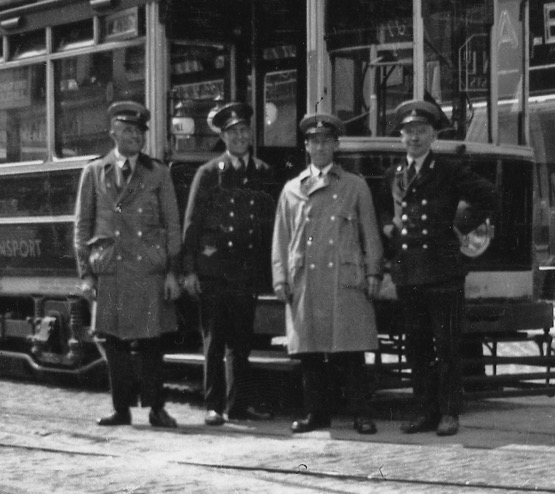
Two crews pose with an unidentified tramcar — photo undated, but almost certainly taken in the late 1930s. Two of those depicted are wearing lightweight dustcoats (probably light brown or beige) and there appear to be no script-lettering cap badges in sight. The photograph was again probably taken by the late Alf Owen, and is reproduced with the kind permission of Mr T Wilson of Travel Lens Photographic.
Senior staff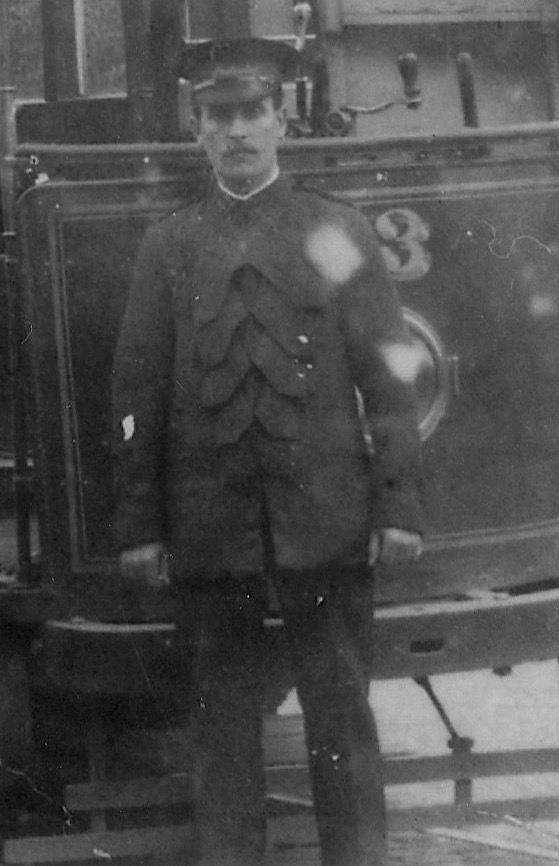
An inspector (taken from the same photo as the crew of Tramcar 23, above). The elaborate jacket was modelled on British Army jackets, with faux loops and corded epaulettes. This photo may well show the same individual pictured with the group of conductresses below. Photo reproduced with the kind permission of Mr T Wilson of Travel Lens Photographic.
Female staff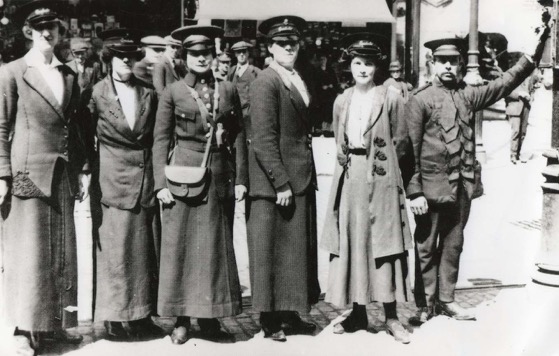
A group of newly recruited conductresses line up for the camera with an inspector — photo undated, but without doubt taken during the Great War. Only one lady appears to have an official uniform, the rest are wearing makeshift outfits. Author's Collection.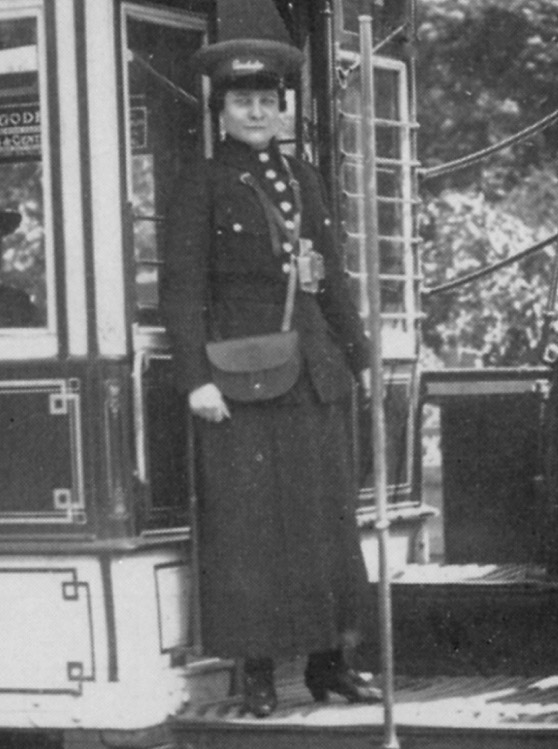
A conductress poses for the camera aboard the platform of Tramcar No 26 — photo undated, but almost certainly taken during the Great War. This lady is probably the same individual pictured in the group photograph above, also in a uniform. Author's Collection.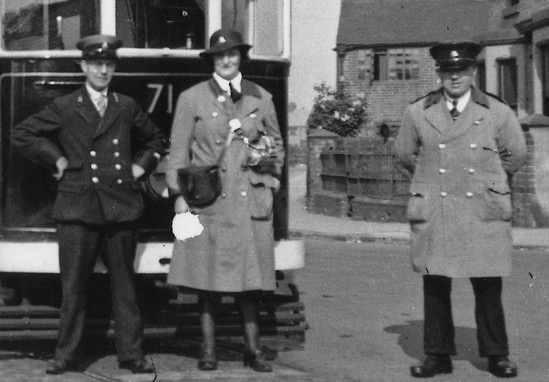
A motorman, a conductress and another tramway employee pose with Tramcar No 71 — photo undated, but more than likely taken in 1940. All the individuals depicted are wearing small municipal-device badges on their cap badges, the grade badges having been dispensed with. The photograph was almost certainly taken by the late Alf Owen, and is reproduced with the kind permission of Mr T Wilson of Travel Lens Photographic.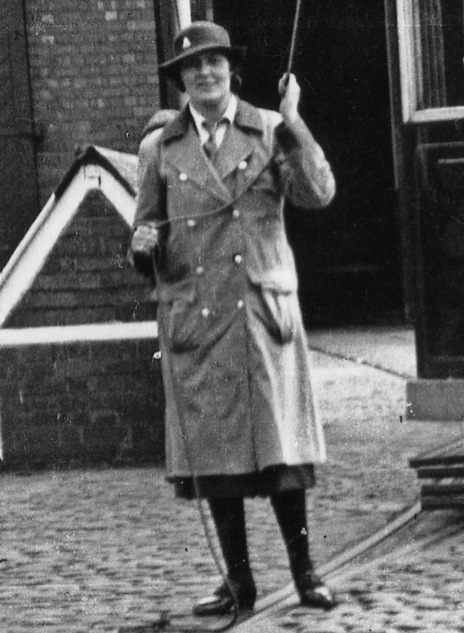
A conductress swings the trolley pole of Tramcar No 46 in the depot yard, possibly at Priestley's Bridge in 1940. The photograph was probably taken by the late Alf Owen, and is reproduced with the kind permission of Mr T Wilson of Travel Lens Photographic.